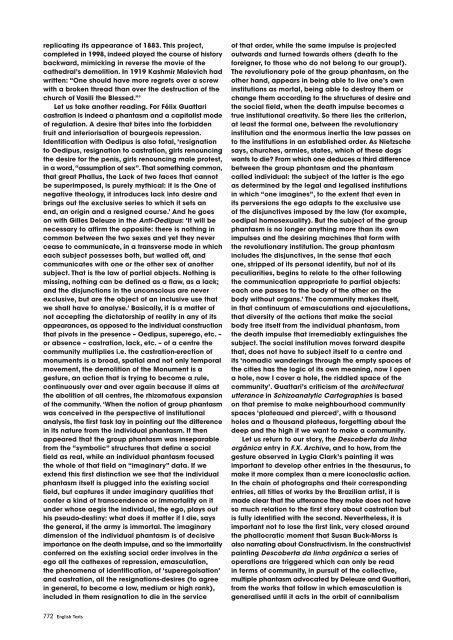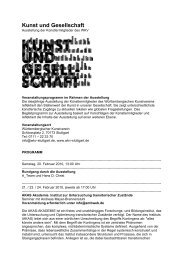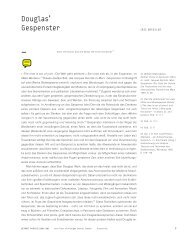English Texts
English Texts
English Texts
Create successful ePaper yourself
Turn your PDF publications into a flip-book with our unique Google optimized e-Paper software.
eplicating its appearance of 1883. This project,<br />
completed in 1998, indeed played the course of history<br />
backward, mimicking in reverse the movie of the<br />
cathedral’s demolition. In 1919 Kashmir Malevich had<br />
written: “One should have more regrets over a screw<br />
with a broken thread than over the destruction of the<br />
church of Vasili the Blessed.”’<br />
Let us take another reading. For Félix Guattari<br />
castration is indeed a phantasm and a capitalist mode<br />
of regulation. A desire that bites into the forbidden<br />
fruit and interiorisation of bourgeois repression.<br />
Identification with Oedipus is also total, ‘resignation<br />
to Oedipus, resignation to castration, girls renouncing<br />
the desire for the penis, girls renouncing male protest,<br />
in a word, “assumption of sex”. That something common,<br />
that great Phallus, the Lack of two faces that cannot<br />
be superimposed, is purely mythical: it is the One of<br />
negative theology, it introduces lack into desire and<br />
brings out the exclusive series to which it sets an<br />
end, an origin and a resigned course.’ And he goes<br />
on with Gilles Deleuze in the Anti-Oedipus: ‘It will be<br />
necessary to affirm the opposite: there is nothing in<br />
common between the two sexes and yet they never<br />
cease to communicate, in a transverse mode in which<br />
each subject possesses both, but walled off, and<br />
communicates with one or the other sex of another<br />
subject. That is the law of partial objects. Nothing is<br />
missing, nothing can be defined as a flaw, as a lack;<br />
and the disjunctions in the unconscious are never<br />
exclusive, but are the object of an inclusive use that<br />
we shall have to analyse.’ Basically, it is a matter of<br />
not accepting the dictatorship of reality in any of its<br />
appearances, as opposed to the individual construction<br />
that pivots in the presence – Oedipus, superego, etc. –<br />
or absence – castration, lack, etc. – of a centre the<br />
community multiplies i.e. the castration-erection of<br />
monuments is a broad, spatial and not only temporal<br />
movement, the demolition of the Monument is a<br />
gesture, an action that is trying to become a rule,<br />
continuously over and over again because it aims at<br />
the abolition of all centres, the rhizomatous expansion<br />
of the community. ‘When the notion of group phantasm<br />
was conceived in the perspective of institutional<br />
analysis, the first task lay in pointing out the difference<br />
in its nature from the individual phantasm. It then<br />
appeared that the group phantasm was inseparable<br />
from the “symbolic” structures that define a social<br />
field as real, while an individual phantasm focused<br />
the whole of that field on “imaginary” data. If we<br />
extend this first distinction we see that the individual<br />
phantasm itself is plugged into the existing social<br />
field, but captures it under imaginary qualities that<br />
confer a kind of transcendence or immortality on it<br />
under whose aegis the individual, the ego, plays out<br />
his pseudo-destiny: what does it matter if I die, says<br />
the general, if the army is immortal. The imaginary<br />
dimension of the individual phantasm is of decisive<br />
importance on the death impulse, and so the immortality<br />
conferred on the existing social order involves in the<br />
ego all the cathexes of repression, emasculation,<br />
the phenomena of identification, of ‘superegoisation’<br />
and castration, all the resignations-desires (to agree<br />
in general, to become a low, medium or high rank),<br />
included in them resignation to die in the service<br />
of that order, while the same impulse is projected<br />
outwards and turned towards others (death to the<br />
foreigner, to those who do not belong to our group!).<br />
The revolutionary pole of the group phantasm, on the<br />
other hand, appears in being able to live one’s own<br />
institutions as mortal, being able to destroy them or<br />
change them according to the structures of desire and<br />
the social field, when the death impulse becomes a<br />
true institutional creativity. So there lies the criterion,<br />
at least the formal one, between the revolutionary<br />
institution and the enormous inertia the law passes on<br />
to the institutions in an established order. As Nietzsche<br />
says, churches, armies, states, which of these dogs<br />
wants to die? From which one deduces a third difference<br />
between the group phantasm and the phantasm<br />
called individual: the subject of the latter is the ego<br />
as determined by the legal and legalised institutions<br />
in which “one imagines”, to the extent that even in<br />
its perversions the ego adapts to the exclusive use<br />
of the disjunctives imposed by the law (for example,<br />
oedipal homosexuality). But the subject of the group<br />
phantasm is no longer anything more than its own<br />
impulses and the desiring machines that form with<br />
the revolutionary institution. The group phantasm<br />
includes the disjunctives, in the sense that each<br />
one, stripped of its personal identity, but not of its<br />
peculiarities, begins to relate to the other following<br />
the communication appropriate to partial objects:<br />
each one passes to the body of the other on the<br />
body without organs.’ The community makes itself,<br />
in that continuum of emasculations and ejaculations,<br />
that diversity of the actions that make the social<br />
body free itself from the individual phantasm, from<br />
the death impulse that irremediably extinguishes the<br />
subject. The social institution moves forward despite<br />
that, does not have to subject itself to a centre and<br />
its ‘nomadic wanderings through the empty spaces of<br />
the cities has the logic of its own meaning, now I open<br />
a hole, now I cover a hole, the riddled space of the<br />
community’. Guattari’s criticism of the architectural<br />
utterance in Schizoanalytic Cartographies is based<br />
on that premise to make neighbourhood community<br />
spaces ‘plateaued and pierced’, with a thousand<br />
holes and a thousand plateaus, forgetting about the<br />
deep and the high if we want to make a community.<br />
Let us return to our story, the Descoberta da linha<br />
orgânica entry in F.X. Archive, and to how, from the<br />
gesture observed in Lygia Clark’s painting it was<br />
important to develop other entries in the thesaurus, to<br />
make it more complex than a mere iconoclastic action.<br />
In the chain of photographs and their corresponding<br />
entries, all titles of works by the Brazilian artist, it is<br />
made clear that the utterance they make does not have<br />
so much relation to the first story about castration but<br />
is fully identified with the second. Nevertheless, it is<br />
important not to lose the first link, very closed around<br />
the phallocratic moment that Susan Buck-Morss is<br />
also narrating about Constructivism. In the constructivist<br />
painting Descoberta da linha orgânica a series of<br />
operations are triggered which can only be read<br />
in terms of community, in pursuit of the collective,<br />
multiple phantasm advocated by Deleuze and Guattari,<br />
from the works that follow in which emasculation is<br />
generalised until it acts in the orbit of cannibalism<br />
772 <strong>English</strong> <strong>Texts</strong>










